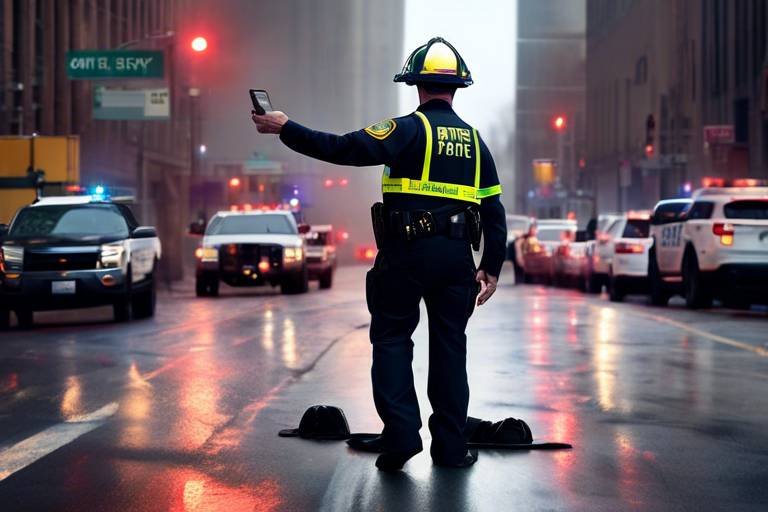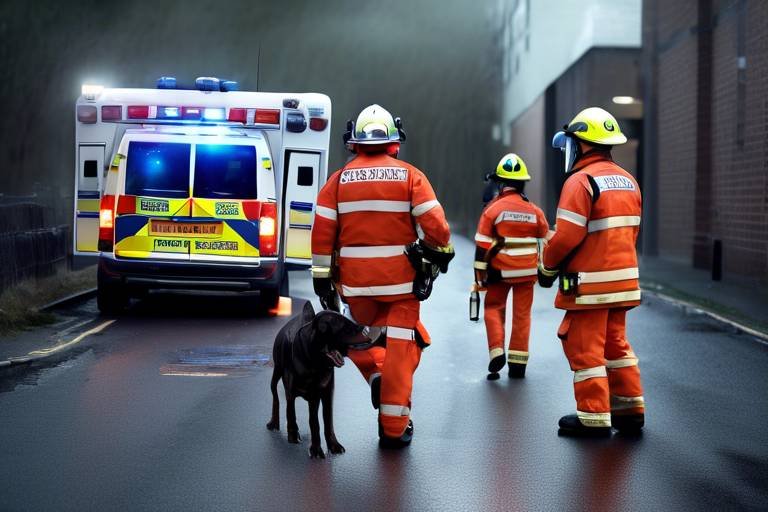How Technology is Enhancing Public Safety
In today's fast-paced world, the intersection of technology and public safety is more critical than ever. As communities face various challenges, from natural disasters to criminal activities, innovative solutions are emerging to enhance safety and security. Technology is not just a tool; it's a lifeline that connects people, empowers responders, and creates a safer environment for everyone. Imagine a world where emergency responders have instant access to vital information, where surveillance systems are so advanced they can predict incidents before they occur, and where citizens are active participants in their own safety. This is not a distant future; this is the reality we're living in today, and it's all thanks to the remarkable advancements in technology.
From smart surveillance systems that utilize artificial intelligence to emergency communication tools that keep us informed during crises, technology is transforming the landscape of public safety. The integration of data analytics allows law enforcement agencies to make informed decisions, while wearable technology enhances the efficiency and safety of first responders. Furthermore, robust cybersecurity measures are essential to protect these advancements from potential threats, ensuring that our public safety infrastructure remains intact. As we delve deeper into these topics, we'll uncover how each of these technologies contributes to a safer community and enhances our overall well-being.
Smart surveillance technologies, such as AI-powered cameras and drones, are revolutionizing public safety by providing real-time monitoring and data analysis. These systems help law enforcement respond swiftly to incidents and deter criminal activities. Imagine walking through a park where drones are monitoring for suspicious behavior, or where cameras can identify potential threats before they escalate. This proactive approach not only enhances safety but also fosters a sense of security among community members. With the ability to analyze vast amounts of data, these technologies can identify patterns and trends, allowing law enforcement to allocate resources more effectively.
When disaster strikes, every second counts. Modern communication tools, including mobile apps and social media, enhance emergency response by enabling rapid information sharing and coordination among first responders. These tools ensure timely assistance during crises and natural disasters, saving lives and minimizing damage. For instance, during a severe weather event, authorities can quickly disseminate critical information to the public, allowing individuals to take necessary precautions.
Mobile alert systems are vital for disseminating critical information to the public during emergencies. These systems allow authorities to communicate effectively and keep citizens informed about safety measures and potential threats. They can send out alerts for various situations, such as severe weather warnings, missing persons, or public safety announcements. The immediacy of these alerts can make all the difference in ensuring community safety.
Text and voice alerts provide immediate notifications to individuals, ensuring they receive timely updates on emergencies, weather warnings, and safety instructions. This technology enhances community preparedness and response, allowing citizens to stay informed and take appropriate action when necessary. Just think about how reassuring it is to receive a text alert about a potential threat, giving you the time to respond effectively.
Dedicated public safety apps empower citizens to report incidents, access emergency resources, and receive alerts. These applications foster a collaborative environment between the public and law enforcement agencies. By making it easy for individuals to report suspicious activities or access emergency contacts, these apps enhance community engagement and promote a culture of safety. The more involved citizens are, the safer the community becomes.
Data analytics plays a crucial role in crime prevention by enabling law enforcement to identify patterns, allocate resources efficiently, and develop targeted strategies that address specific community safety concerns. By analyzing historical crime data, police departments can predict where incidents are likely to occur and deploy resources accordingly. This proactive approach not only helps in preventing crime but also builds trust between law enforcement and the community.
Wearable technology, such as smart helmets and body cameras, enhances the safety and efficiency of first responders. These devices provide real-time data, improving situational awareness and ensuring accountability during emergency operations. For example, body cameras worn by police officers promote transparency and accountability, capturing critical evidence during interactions and enhancing public trust in law enforcement practices.
Body cameras are a game-changer for law enforcement. They capture every interaction, providing an unbiased account of events that can be crucial for investigations and court proceedings. This transparency not only protects the rights of citizens but also ensures officers are held accountable for their actions, fostering a culture of trust and respect within the community.
Smart helmets equipped with augmented reality provide first responders with essential information, such as building layouts and hazard warnings. This technology improves their decision-making capabilities in high-pressure situations, allowing them to act swiftly and effectively. Imagine a firefighter entering a burning building with real-time data about the structure; it could mean the difference between life and death.
In an increasingly digital world, robust cybersecurity measures are essential for protecting public safety infrastructure from cyber threats. Ensuring that critical systems remain operational and safeguarding sensitive data related to emergency services and law enforcement is paramount. As we rely more on technology, the risks associated with cyberattacks grow, making it imperative for organizations to invest in advanced security protocols.
Advanced threat detection systems utilize artificial intelligence to monitor networks for suspicious activities. These systems enable organizations to respond proactively to potential cyberattacks that could compromise public safety. By continuously analyzing data and identifying anomalies, these systems provide an added layer of security that is crucial in today's digital landscape.
Training and awareness programs for public safety personnel are vital for understanding cybersecurity risks. Ensuring that first responders are equipped to handle digital threats and protect community safety effectively is essential. Regular training sessions and updates on the latest cybersecurity trends can make a significant difference in how well prepared these individuals are to face potential challenges.
- How does technology improve emergency response times?
Technology streamlines communication between first responders and the public, allowing for quicker dispatch and coordination during emergencies.
- What role does data analytics play in crime prevention?
Data analytics helps law enforcement identify crime patterns, enabling them to allocate resources more effectively and prevent future incidents.
- Are public safety apps effective?
Yes, public safety apps empower citizens to engage with law enforcement, report incidents, and receive real-time alerts, enhancing community safety.

Smart Surveillance Systems
In today's fast-paced world, are becoming an essential component of public safety. These advanced technologies, including AI-powered cameras and drones, are transforming the landscape of law enforcement and community safety. Imagine a city where law enforcement can monitor multiple areas in real-time, responding to incidents before they escalate. This is not a scene from a sci-fi movie; it’s the reality brought about by smart surveillance.
At the heart of these systems is the ability to analyze vast amounts of data quickly. Traditional surveillance methods often relied on human operators watching feeds, which could lead to missed incidents or delayed responses. However, with the integration of artificial intelligence, these smart systems can detect unusual behaviors and alert authorities immediately. For instance, if a camera spots a person loitering in a high-crime area, it can send an instant alert to nearby officers, enabling them to investigate before a crime occurs.
Moreover, drones equipped with high-resolution cameras are taking surveillance to new heights—literally. These flying eyes in the sky can cover large areas in a fraction of the time it would take ground patrols. In emergency situations, drones can provide real-time aerial views, helping first responders assess the scene and allocate resources effectively. The ability to see from above can make a significant difference in situations like natural disasters or large public events, where safety is a top priority.
But what about privacy concerns? It’s a valid question. As we embrace these technologies, it’s crucial to establish guidelines that protect citizens' privacy while enhancing safety. Many cities are implementing strict regulations on how surveillance data is collected, stored, and used, ensuring that the benefits of smart surveillance do not come at the expense of individual rights.
To illustrate the impact of smart surveillance systems, consider the following table that compares traditional surveillance methods with smart technologies:
| Aspect | Traditional Surveillance | Smart Surveillance |
|---|---|---|
| Data Analysis | Manual monitoring | AI-driven analysis |
| Response Time | Delayed response | Real-time alerts |
| Coverage Area | Limited by manpower | Wide coverage with drones |
| Privacy Concerns | Less regulated | Strict guidelines in place |
In conclusion, smart surveillance systems are not just about enhancing public safety; they are about creating a safer environment for everyone. By leveraging technology, law enforcement can respond to incidents faster, deter crime more effectively, and ultimately build a stronger relationship with the communities they serve. As we continue to innovate, the future of public safety looks promising, with smart surveillance at the forefront of these advancements.
- What are smart surveillance systems? Smart surveillance systems use advanced technologies like AI and drones to monitor areas in real-time, enhancing public safety.
- How do AI-powered cameras work? They analyze video feeds to detect unusual behavior and send alerts to law enforcement, enabling quicker responses.
- Are there privacy concerns with smart surveillance? Yes, but many cities are implementing regulations to protect individual privacy while using these systems.
- How do drones contribute to public safety? Drones provide aerial views of incidents, allowing for better assessment and resource allocation during emergencies.

Emergency Communication Tools
In today's fast-paced world, the importance of effective communication during emergencies cannot be overstated. Modern technology has revolutionized how we respond to crises, making it easier than ever for first responders and the general public to stay connected. With the rise of mobile apps and social media platforms, information can be shared rapidly, allowing for coordinated efforts that can save lives. Imagine a scenario where a natural disaster strikes; the ability for authorities to communicate instantly with citizens can make all the difference in ensuring safety and preparedness.
One of the most significant advancements in emergency communication is the development of mobile alert systems. These systems are designed to disseminate critical information to the public quickly and efficiently. When an emergency occurs, whether it’s a severe weather warning or an active shooter situation, authorities can send out alerts to keep citizens informed about safety measures and potential threats. This is crucial because timely information can empower individuals to make informed decisions about their safety.
To illustrate the effectiveness of these tools, consider the following types of alerts that can be sent out:
- Text Alerts: These are immediate notifications sent directly to individuals' mobile devices, ensuring they receive updates on emergencies and safety instructions.
- Voice Alerts: Automated voice messages can also be sent to landlines and mobile phones, providing essential information for those who may not have access to text messages.
Moreover, dedicated public safety apps have emerged as powerful tools that empower citizens. These apps allow individuals to report incidents, access emergency resources, and receive real-time alerts. For instance, users can report suspicious activities or request help, fostering a collaborative environment between the public and law enforcement agencies. By bridging the gap between citizens and first responders, these apps enhance community security and instill a sense of shared responsibility.
As we look at the future of emergency communication, it is essential to recognize the role of social media. Platforms like Twitter and Facebook have become vital channels for disseminating information during crises. Authorities can provide live updates, share safety tips, and even debunk false information, ensuring that the public remains well-informed. Social media not only facilitates communication but also serves as a platform for community engagement, allowing people to share their experiences and support one another in times of need.
In conclusion, the evolution of emergency communication tools has significantly improved our ability to respond to crises. By leveraging mobile alert systems, public safety apps, and social media, we can enhance community preparedness and ensure that timely assistance reaches those in need. As technology continues to advance, the potential for even more innovative solutions in emergency communication is limitless, promising a safer and more connected future for all.
Q: How do mobile alert systems work?
A: Mobile alert systems send out notifications to subscribers' mobile devices during emergencies, providing critical information like safety measures and potential threats.
Q: Can anyone access public safety apps?
A: Yes, public safety apps are typically available for download by anyone, allowing citizens to report incidents and receive alerts.
Q: How does social media contribute to emergency communication?
A: Social media platforms allow authorities to share live updates and safety information during emergencies, helping to keep the public informed and engaged.

Mobile Alert Systems
In today's fast-paced world, have become an indispensable part of our emergency response framework. These systems are designed to disseminate critical information swiftly, ensuring that the public remains informed during emergencies. Imagine receiving a text message alerting you to a severe weather warning while you’re at home, or a notification about a nearby incident that could affect your safety. This is the power of mobile alert systems!
These systems leverage modern technology to send out instant notifications to individuals, allowing authorities to communicate effectively and keep citizens informed about safety measures and potential threats. They can reach people through various channels, including SMS, mobile apps, and even social media platforms. The versatility of these systems ensures that information is accessible to everyone, regardless of their preferred communication method.
One of the key benefits of mobile alert systems is their ability to provide timely updates during crises. For instance, during a natural disaster, authorities can use these systems to inform residents about evacuation routes, shelter locations, and safety protocols. This rapid dissemination of information can be the difference between safety and danger, making it crucial for communities to adopt such technologies.
To illustrate the effectiveness of mobile alert systems, consider the following table that highlights their key features:
| Feature | Description |
|---|---|
| Real-Time Alerts | Instant notifications about emergencies, ensuring the public receives timely information. |
| Multi-Channel Communication | Information can be sent via SMS, mobile apps, and social media, reaching a broader audience. |
| User-Friendly | Most systems are easy to use, allowing citizens to opt-in for alerts with minimal effort. |
| Geographical Targeting | Alerts can be sent to specific areas, ensuring that only those affected receive relevant information. |
Moreover, mobile alert systems empower citizens to take proactive measures in response to emergencies. When individuals are informed about potential threats, they can make informed decisions, whether it’s evacuating an area or seeking shelter. This sense of empowerment fosters a culture of preparedness, where communities are better equipped to handle crises.
In conclusion, mobile alert systems are not just a technological advancement; they are a vital tool in enhancing public safety. By facilitating rapid information sharing, these systems play a crucial role in ensuring that communities remain informed and prepared in the face of emergencies. As we continue to embrace technological innovations, investing in mobile alert systems should be a top priority for communities aiming to enhance their emergency response capabilities.
- What are mobile alert systems? Mobile alert systems are communication tools designed to disseminate critical information to the public during emergencies through various channels.
- How do I sign up for mobile alerts? Typically, you can sign up for mobile alerts through your local government or emergency management agency's website or mobile app.
- Are mobile alerts free? Yes, most mobile alert systems are free for users, although standard text messaging rates may apply.
- Can I customize the alerts I receive? Many systems allow users to customize their alert preferences based on location and types of emergencies.

Text and Voice Alerts
In today's fast-paced world, staying informed during emergencies is crucial for ensuring public safety. Text and voice alerts serve as vital communication tools that provide immediate notifications to individuals, keeping them updated on critical situations. Imagine receiving a text message that warns you of an approaching storm or a voice alert that instructs you on safety measures during a local emergency. These technologies not only enhance community preparedness but also empower citizens to take swift action when necessary.
The effectiveness of text and voice alerts lies in their ability to reach a wide audience in a matter of seconds. Authorities can send out messages to thousands of people simultaneously, ensuring that everyone is aware of potential threats. This rapid dissemination of information can be the difference between safety and danger. For instance, during a natural disaster, timely alerts can guide residents to evacuate or seek shelter, thereby saving lives.
Moreover, these alerts are not just one-way communications. They often allow for two-way interaction, enabling individuals to respond or ask questions. This feature is particularly useful during crises when people may need clarification on what actions to take. Additionally, many systems now integrate with mobile apps, allowing users to customize their alert preferences based on their location and personal safety needs.
To give you a clearer picture of how these systems work, consider the following table that outlines the key features and benefits of text and voice alert systems:
| Feature | Benefit |
|---|---|
| Real-time Notifications | Immediate updates on emergencies, allowing for quick decision-making. |
| Wide Reach | Ability to notify large populations simultaneously, ensuring no one is left uninformed. |
| Two-way Communication | Allows individuals to ask questions and get real-time feedback during emergencies. |
| Customizable Alerts | Users can tailor notifications based on their location and preferences, enhancing relevance. |
In conclusion, text and voice alerts are indispensable tools in the realm of public safety. By leveraging these technologies, authorities can ensure that citizens are well-informed and prepared to respond to emergencies effectively. As we continue to embrace technological advancements, it is evident that these alert systems play a crucial role in fostering a safer community.
- How do I sign up for text and voice alerts?
Most local governments and emergency services provide online registration through their websites. You can also check if your mobile carrier supports emergency alerts. - Are text and voice alerts free?
Yes, generally, these alerts are free to receive, but standard messaging rates may apply depending on your mobile plan. - What types of emergencies will I receive alerts for?
Alerts can include severe weather warnings, public safety threats, natural disasters, and other emergencies as determined by local authorities. - Can I customize the alerts I receive?
Yes, many systems allow you to choose the types of alerts you want to receive based on your preferences and location.

Public Safety Apps
In today's fast-paced world, have emerged as essential tools that not only empower citizens but also bridge the gap between the community and law enforcement agencies. These innovative applications serve multiple purposes, from reporting crimes to accessing emergency resources, making them invaluable in enhancing public safety. Imagine having the ability to report a suspicious activity with just a few taps on your smartphone; this is the reality that these apps provide. They foster a collaborative environment where citizens can play an active role in their own safety and that of their neighbors.
One of the standout features of public safety apps is their ability to deliver real-time alerts and updates. For instance, during a natural disaster or emergency situation, these apps can push notifications directly to users' devices, informing them about evacuation routes, shelter locations, and safety measures. This immediate access to information is crucial for ensuring that communities can respond quickly and effectively to threats. Moreover, many of these apps allow users to customize their alert preferences, ensuring that they receive the information that matters most to them.
Additionally, public safety apps often include features that enable users to connect directly with law enforcement. Through these platforms, citizens can submit tips, share information anonymously, and even upload photos or videos that may assist in investigations. This level of engagement not only helps in crime prevention but also builds trust between the community and police. When people feel that their voices are heard and their contributions valued, they are more likely to participate in community safety initiatives.
Furthermore, these apps frequently incorporate educational resources, such as safety tips and emergency preparedness guidelines. By educating users on how to respond in various situations—be it a fire, flood, or active shooter scenario—public safety apps promote a culture of preparedness. This proactive approach is essential in reducing panic during emergencies and ensuring that individuals know how to protect themselves and their loved ones.
As technology continues to evolve, we can expect public safety apps to become even more sophisticated. Future developments may include features like location tracking for emergency responders, integration with smart home devices, and enhanced data analytics to better predict and respond to community safety needs. The potential is limitless, and as communities embrace these tools, the overall safety and security of our neighborhoods will undoubtedly improve.
1. What are public safety apps?
Public safety apps are mobile applications designed to enhance community safety by enabling citizens to report incidents, receive alerts, and access emergency resources.
2. How do public safety apps improve communication between citizens and law enforcement?
These apps allow users to submit tips, share information anonymously, and receive real-time updates from law enforcement, fostering a collaborative relationship.
3. Can public safety apps help during natural disasters?
Yes, public safety apps provide critical information during emergencies, such as evacuation routes and shelter locations, helping communities respond effectively.
4. Are public safety apps user-friendly?
Most public safety apps are designed with user experience in mind, making them easy to navigate and accessible for individuals of all ages.
5. Will public safety apps continue to evolve?
Absolutely! As technology advances, we can expect public safety apps to incorporate new features and enhancements that further improve community safety.

Data Analytics for Crime Prevention
In today's world, data analytics is becoming a cornerstone of effective crime prevention strategies. Law enforcement agencies are increasingly turning to advanced analytics to sift through vast amounts of data, helping them identify patterns and trends that may indicate criminal activity. Imagine being able to predict where a crime is likely to occur before it even happens! This proactive approach not only enhances public safety but also allows police departments to allocate their resources more efficiently.
One of the most significant benefits of utilizing data analytics in crime prevention is the ability to detect patterns. For instance, by analyzing historical crime data, law enforcement can identify hotspots where criminal activity is more likely to occur. This information can then guide patrol routes, ensuring that officers are present in areas that need them the most. Additionally, predictive analytics can help in understanding the time frames during which crimes are most likely to be committed, allowing for more strategic deployment of resources.
Moreover, data analytics can be instrumental in addressing specific community safety concerns. By utilizing community feedback and crime reports, police can tailor their strategies to target the unique needs of different neighborhoods. For example, if data shows a spike in vehicle thefts in a particular area, law enforcement can implement targeted initiatives such as increased patrols, community awareness campaigns, or even partnerships with local businesses to enhance surveillance efforts.
To illustrate the impact of data analytics on crime prevention, consider the following table that highlights key areas where analytics is making a difference:
| Area of Impact | Description |
|---|---|
| Crime Trend Analysis | Analyzing past crime data to identify trends and predict future incidents. |
| Resource Allocation | Optimizing police presence based on data-driven insights about crime hotspots. |
| Community Engagement | Using feedback and reports from citizens to tailor policing strategies. |
| Real-Time Monitoring | Utilizing data from surveillance systems to respond quickly to incidents. |
Furthermore, the integration of social media analytics is also gaining traction in crime prevention efforts. Law enforcement agencies are monitoring social media platforms to gather intelligence on potential threats or criminal activities. By analyzing posts, comments, and shared content, they can identify emerging trends or public sentiments that may indicate unrest or criminal intentions. This type of intelligence is invaluable in preventing crime before it escalates.
In conclusion, data analytics is not just a tool; it’s a powerful ally in the fight against crime. By leveraging technology and data, law enforcement agencies can make informed decisions that enhance community safety and build trust with the public. As technology continues to evolve, the potential for data analytics in crime prevention will only grow, paving the way for safer communities.
- What is data analytics in crime prevention? Data analytics involves examining data to identify patterns and trends that can help law enforcement predict and prevent criminal activities.
- How does data analytics improve police resource allocation? By analyzing crime data, police can determine high-crime areas and deploy officers more effectively to prevent crime.
- Can social media be used in crime prevention? Yes, law enforcement monitors social media to gather intelligence and identify potential criminal activities or threats.
- Is data analytics effective in all communities? While data analytics can be beneficial in many areas, its effectiveness may vary depending on the availability of data and specific community needs.

Wearable Technology for First Responders
This article explores the various ways technology contributes to public safety, including advancements in communication systems, surveillance, data analysis, and emergency response, highlighting innovative tools and methods that improve community security.
Smart surveillance technologies, such as AI-powered cameras and drones, are revolutionizing public safety by providing real-time monitoring and data analysis, helping law enforcement respond swiftly to incidents and deterring criminal activities.
Modern communication tools, including mobile apps and social media, enhance emergency response by enabling rapid information sharing and coordination among first responders, ensuring timely assistance during crises and natural disasters.
Mobile alert systems are vital for disseminating critical information to the public during emergencies, allowing authorities to communicate effectively and keep citizens informed about safety measures and potential threats.
Text and voice alerts provide immediate notifications to individuals, ensuring they receive timely updates on emergencies, weather warnings, and safety instructions, thereby enhancing community preparedness and response.
Dedicated public safety apps empower citizens to report incidents, access emergency resources, and receive alerts, fostering a collaborative environment between the public and law enforcement agencies.
Data analytics plays a crucial role in crime prevention by enabling law enforcement to identify patterns, allocate resources efficiently, and develop targeted strategies that address specific community safety concerns.
Wearable technology is transforming the landscape of emergency response, providing first responders with tools that not only enhance their safety but also improve their operational efficiency. Imagine a firefighter entering a burning building, equipped with a smart helmet that overlays critical information right before their eyes. This technology allows them to visualize the building layout, identify potential hazards, and make informed decisions in real-time. Such innovations are not just science fiction; they are becoming a reality, and they are saving lives.
One significant advancement is the use of body cameras. These devices promote transparency and accountability by capturing interactions between law enforcement and the public. Body cameras not only serve as a record of events but also enhance the safety of officers by providing evidence in case of disputes. The trust built through this transparency can lead to better community relations and cooperation with law enforcement.
Additionally, smart helmets equipped with augmented reality (AR) offer a plethora of benefits for first responders:
- Real-Time Data Access: First responders can access vital information such as blueprints, hazard warnings, and real-time updates on the situation they are facing.
- Enhanced Communication: These helmets can facilitate seamless communication among team members, allowing for better coordination during emergencies.
- Training Simulations: AR technology can be used for training purposes, simulating various emergency scenarios to prepare responders for real-life situations.
As we look towards the future, the integration of wearable technology in public safety continues to evolve. With advancements in connectivity and data processing, the potential for these tools is limitless. They not only enhance the capabilities of first responders but also ensure that they are better prepared to face the challenges that come with their critical roles.
Robust cybersecurity measures are essential for protecting public safety infrastructure from cyber threats, ensuring that critical systems remain operational and safeguarding sensitive data related to emergency services and law enforcement.
Advanced threat detection systems utilize artificial intelligence to monitor networks for suspicious activities, enabling organizations to respond proactively to potential cyberattacks that could compromise public safety.
Training and awareness programs for public safety personnel are vital for understanding cybersecurity risks, ensuring that first responders are equipped to handle digital threats and protect community safety effectively.
Q: How does wearable technology improve first responders' safety?
A: Wearable technology enhances safety by providing real-time data, improving situational awareness, and ensuring accountability during emergency operations.
Q: What are the benefits of body cameras for law enforcement?
A: Body cameras promote transparency, provide critical evidence during interactions, and enhance public trust in law enforcement practices.
Q: How do smart helmets assist first responders?
A: Smart helmets equipped with augmented reality provide essential information, such as building layouts and hazard warnings, improving decision-making capabilities in high-pressure situations.

Body Cameras
Body cameras have emerged as a transformative tool in the realm of law enforcement, acting as a bridge between police officers and the communities they serve. These devices, worn on the uniform, offer a transparent view of police interactions, capturing everything from routine traffic stops to critical incidents. The implementation of body cameras not only enhances accountability but also fosters a sense of trust within the community. When citizens know that their interactions with law enforcement are being recorded, it encourages both parties to act responsibly.
Moreover, the data collected from body cameras can be invaluable in investigations and court proceedings. In many cases, video evidence can provide clarity in situations where accounts of events may differ. This not only helps in establishing the facts but also in protecting officers from false accusations. The use of body cameras has proven to be a game-changer in promoting transparency and integrity in law enforcement practices.
However, the deployment of body cameras is not without its challenges. Concerns regarding privacy, data storage, and access to footage are significant. To address these issues, many police departments have established clear policies outlining when cameras should be activated and how the footage will be stored and accessed. This careful consideration ensures that while officers are held accountable, the privacy rights of citizens are also respected.
In addition to accountability, body cameras play a crucial role in training and education. Footage from these devices can be used to analyze police conduct and decision-making in real-time scenarios. This information can then be incorporated into training programs, providing officers with a better understanding of how to handle various situations effectively. As a result, body cameras not only serve as a tool for monitoring behavior but also as a resource for ongoing professional development.
In conclusion, body cameras represent a significant advancement in public safety technology. They enhance accountability, provide critical evidence, and improve training for law enforcement officers. As communities continue to seek ways to build trust with their police departments, body cameras stand out as a vital component in fostering a safer and more transparent environment for all.
- What are the primary benefits of body cameras?
Body cameras enhance accountability, provide evidence for investigations, and improve community trust in law enforcement. - How is the footage from body cameras stored?
Footage is typically stored in secure cloud-based systems or local servers, with strict access controls to protect privacy. - Are there privacy concerns associated with body cameras?
Yes, privacy concerns exist, and many police departments have established policies to address when cameras should be activated and how footage is used. - Can body camera footage be used in court?
Absolutely, body camera footage can serve as critical evidence in legal proceedings, helping to clarify events and establish facts.

Smart Helmets
In the ever-evolving landscape of public safety, are emerging as a groundbreaking tool for first responders. Imagine a firefighter entering a blazing building, equipped not just with protective gear but also with a helmet that feeds them crucial information in real-time. These helmets are not just about protection; they are about enhancing situational awareness and improving decision-making under pressure.
Smart helmets are equipped with augmented reality (AR) technology, which overlays critical data onto the user's field of vision. This can include building layouts, hazard warnings, and even vital statistics about individuals who may be trapped inside. For instance, a firefighter could see a digital map of the building's layout right in front of their eyes, helping them navigate through smoke and debris more effectively. This technology not only saves time but also enhances safety by minimizing the risks associated with navigating unknown environments.
Moreover, these helmets often come with integrated communication systems, allowing first responders to stay in constant contact with their team. This feature is crucial during emergencies where every second counts. With a simple voice command, responders can share information about their surroundings or request backup without needing to fumble for a radio. This seamless communication can be the difference between life and death in critical situations.
To illustrate the benefits of smart helmets, consider the following table that highlights their key features:
| Feature | Description |
|---|---|
| Augmented Reality | Displays real-time data such as maps and hazard alerts. |
| Integrated Communication | Allows for hands-free communication among team members. |
| Environmental Sensors | Monitors air quality and temperature to ensure safety. |
| Camera Systems | Records incidents for evidence and training purposes. |
As we delve deeper into the world of smart helmets, we can see that they represent a fusion of technology and safety that is transforming how first responders operate. By providing essential information at a glance and ensuring constant connectivity, these helmets empower users to make informed decisions quickly. This is particularly vital in chaotic environments where traditional methods of communication and navigation may falter.
In conclusion, are not just a trend; they are a necessary evolution in public safety technology. As first responders continue to face increasingly complex challenges, equipping them with the best tools available is essential. The integration of AR and communication technologies into helmets is a game-changer, enhancing their ability to save lives and protect communities.
- What are smart helmets? Smart helmets are advanced protective gear equipped with augmented reality and communication technology, designed to enhance the safety and efficiency of first responders.
- How do smart helmets improve safety? They provide real-time data, improve situational awareness, and facilitate seamless communication, allowing first responders to make informed decisions quickly.
- Can smart helmets be used in all emergency situations? Yes, they are versatile and can be beneficial in various emergencies, including fires, natural disasters, and rescue operations.
- Are smart helmets expensive? While they may have a higher upfront cost compared to traditional helmets, the benefits they offer in terms of safety and efficiency can justify the investment.

Cybersecurity Measures
In today's digital age, where technology intertwines with daily life, have become more crucial than ever for protecting public safety infrastructure. Imagine a city where emergency services are paralyzed due to a cyberattack; the consequences could be catastrophic. This is why robust cybersecurity protocols are essential for ensuring that critical systems, such as those used by law enforcement and emergency responders, remain operational and secure. Without these measures, sensitive data related to public safety could fall into the wrong hands, leading to dire outcomes.
One of the most effective ways to safeguard these systems is through the implementation of advanced threat detection systems. These systems utilize artificial intelligence to monitor networks for any suspicious activities. By analyzing patterns and detecting anomalies in real-time, organizations can respond proactively to potential cyberattacks. This not only mitigates risks but also enhances the overall resilience of public safety operations. For instance, if a network anomaly is detected, cybersecurity teams can initiate immediate investigations to determine if there is a breach, thereby protecting sensitive information and maintaining public trust.
Moreover, it’s not just about having the right technology in place; it’s also about training and awareness programs for public safety personnel. These programs are vital for educating first responders about the various cybersecurity risks they may face. With the increasing reliance on technology, understanding how to recognize and respond to digital threats is paramount. Imagine a police officer who is trained to spot not only physical dangers but also potential cyber threats. This dual awareness can significantly enhance community safety. Training sessions can cover topics such as:
- Identifying phishing attempts
- Understanding malware and ransomware
- Implementing secure communication practices
By equipping first responders with knowledge and skills to face digital challenges, we can create a more secure environment for everyone. The integration of cybersecurity into public safety training helps ensure that personnel are not only prepared for physical emergencies but also for the digital threats that can accompany them.
In conclusion, as we advance further into a technology-driven world, the need for robust cybersecurity measures in public safety becomes increasingly clear. The combination of advanced threat detection systems and comprehensive training programs creates a formidable defense against cyber threats. When public safety agencies prioritize cybersecurity, they not only protect their operations but also foster a sense of security within the community. After all, in a world where technology can both help and hinder, being prepared is the best strategy.
Q1: Why are cybersecurity measures important for public safety?
A1: Cybersecurity measures are crucial for protecting sensitive data and ensuring that emergency services remain operational during a cyberattack. They help prevent breaches that could compromise public safety.
Q2: What role does artificial intelligence play in cybersecurity?
A2: Artificial intelligence is used in advanced threat detection systems to monitor networks for suspicious activities, allowing for proactive responses to potential cyber threats.
Q3: How can first responders be trained to handle cybersecurity risks?
A3: Training programs can educate first responders about recognizing phishing attempts, understanding malware, and implementing secure communication practices, thereby enhancing their preparedness for digital threats.

Threat Detection Systems
In today's digital age, where information flows faster than ever, have become the backbone of public safety. These advanced systems utilize artificial intelligence to sift through vast amounts of data, identifying suspicious activities and potential threats before they escalate into serious incidents. Imagine having a digital watchdog that never sleeps, constantly monitoring for signs of danger. That's the power of threat detection technology!
One of the most impressive features of these systems is their ability to learn and adapt. By analyzing historical data, they can spot patterns that might go unnoticed by human eyes. For instance, if a particular area experiences a spike in suspicious online behavior, the system can alert authorities to investigate further. This proactive approach not only helps in preventing crimes but also in allocating resources more effectively. Instead of waiting for incidents to occur, law enforcement can act on insights derived from data, ensuring a safer community.
Moreover, threat detection systems are not just limited to monitoring networks. They can also be integrated with various public safety infrastructures, such as surveillance cameras and emergency response systems. This integration creates a comprehensive safety net, allowing for real-time communication between different departments and agencies. When a potential threat is detected, the system can automatically notify the relevant authorities, ensuring a swift response.
To give you a clearer picture of how these systems function, let's take a look at the components that make them effective:
| Component | Function |
|---|---|
| Data Collection | Gathers information from various sources, including social media, surveillance feeds, and public reports. |
| Analysis Engine | Processes the collected data to identify trends and anomalies that may indicate a threat. |
| Alert System | Notifies law enforcement and emergency responders in real-time when a potential threat is detected. |
| Reporting Tools | Generates reports and dashboards for analysis, helping authorities make informed decisions. |
While the benefits are clear, it's essential to address concerns regarding privacy and data security. With great power comes great responsibility, and the implementation of threat detection systems must be balanced with the need to protect individual rights. Public awareness and transparent policies are crucial to ensure that these technologies are used ethically and effectively.
In summary, threat detection systems are a game changer for public safety. They not only enhance the ability of law enforcement to respond to threats but also foster a culture of prevention. As technology continues to evolve, so too will these systems, paving the way for a safer future for our communities.
- What is a threat detection system?
A threat detection system is an advanced technology that monitors data and activities to identify potential threats to public safety, using artificial intelligence and machine learning.
- How does it protect public safety?
By analyzing patterns and anomalies in data, these systems can alert authorities to potential dangers before they escalate, allowing for proactive responses.
- Are there privacy concerns with these systems?
Yes, while they enhance safety, it's crucial to implement them with respect for individual privacy rights and to have transparent policies in place.
- Can these systems work with existing public safety infrastructure?
Absolutely! Threat detection systems can be integrated with surveillance cameras, emergency response systems, and other public safety tools for comprehensive monitoring.

Training and Awareness Programs
In today's rapidly evolving landscape of technology and public safety, are absolutely essential. These initiatives equip public safety personnel with the knowledge and skills they need to tackle not only traditional threats but also the rising tide of cybersecurity risks. Imagine a firefighter who knows how to operate a fire truck but lacks the training to navigate a digital emergency—this is where training becomes vital.
These programs often include a mix of theoretical knowledge and practical exercises, ensuring that first responders can effectively manage both physical and digital crises. For instance, a comprehensive training module might cover:
- Understanding basic cybersecurity principles
- Identifying potential digital threats
- Responding to cyber incidents
- Utilizing technology effectively during emergencies
Moreover, these training sessions not only focus on the technical aspects but also emphasize the importance of communication and collaboration. When first responders understand the potential cybersecurity threats, they can work more effectively with IT professionals and cybersecurity experts, creating a unified front against any potential crisis.
To illustrate the impact of these programs, consider the following table showcasing the outcomes of implementing robust training initiatives:
| Training Program | Outcome | Duration |
|---|---|---|
| Cybersecurity Awareness | Increased threat detection rates by 40% | 4 weeks |
| Emergency Response Simulation | Improved response times by 30% | 2 weeks |
| Collaboration with IT | Enhanced communication during crises | Ongoing |
As first responders engage in these training programs, they not only become more adept at handling emergencies but also foster a culture of awareness and preparedness within their communities. This is crucial because, in times of crisis, the ability to communicate effectively and respond quickly can mean the difference between chaos and order.
Furthermore, these programs often include continuous learning opportunities. With the pace of technological advancement, it’s vital for public safety personnel to stay updated on the latest tools and techniques. Regular workshops, online courses, and simulation exercises can keep their skills sharp and their knowledge current.
In conclusion, investing in training and awareness programs is not just a good practice; it’s a necessity. By empowering first responders with the right tools and knowledge, we enhance public safety and build a resilient community ready to face any challenge, whether it be physical or digital. So, the next time you hear about a training initiative, remember that it’s not just about learning—it's about saving lives.
Q1: What types of training are most effective for public safety personnel?
A1: Effective training often combines theoretical knowledge with practical exercises, focusing on both physical emergencies and cybersecurity threats.
Q2: How often should training programs be updated?
A2: Given the rapid pace of technological advancement, training programs should be updated regularly, with ongoing learning opportunities provided.
Q3: Who should conduct these training programs?
A3: Training should ideally be conducted by experts in both public safety and cybersecurity to ensure comprehensive coverage of all relevant topics.
Frequently Asked Questions
- How do smart surveillance systems enhance public safety?
Smart surveillance systems, equipped with AI-powered cameras and drones, provide real-time monitoring and data analysis. This technology helps law enforcement respond quickly to incidents and deters criminal activities by ensuring a visible presence and swift action.
- What role do emergency communication tools play during crises?
Emergency communication tools, like mobile apps and social media, enhance coordination among first responders. They enable rapid information sharing, ensuring timely assistance during crises and natural disasters, ultimately saving lives.
- What are mobile alert systems and why are they important?
Mobile alert systems are critical for disseminating information during emergencies. They allow authorities to communicate effectively with the public about safety measures, potential threats, and updates, keeping citizens informed and prepared.
- How do body cameras contribute to public safety?
Body cameras worn by police officers promote transparency and accountability. They capture vital evidence during interactions, enhancing public trust in law enforcement while ensuring the safety of officers by providing a record of events.
- What are the benefits of wearable technology for first responders?
Wearable technology, like smart helmets, provides first responders with real-time data and situational awareness. This technology improves decision-making in high-pressure situations, ensuring that they can respond effectively to emergencies.
- Why is cybersecurity important for public safety?
Robust cybersecurity measures protect public safety infrastructure from cyber threats. By safeguarding critical systems and sensitive data, we can ensure that emergency services and law enforcement remain operational and effective in protecting communities.
- What are threat detection systems and how do they work?
Advanced threat detection systems utilize artificial intelligence to monitor networks for suspicious activities. They enable organizations to respond proactively to potential cyberattacks, thereby safeguarding public safety infrastructure from digital threats.
- How can training and awareness programs improve public safety?
Training and awareness programs equip public safety personnel with knowledge about cybersecurity risks. This ensures that first responders are prepared to handle digital threats effectively, protecting community safety in an increasingly connected world.


















